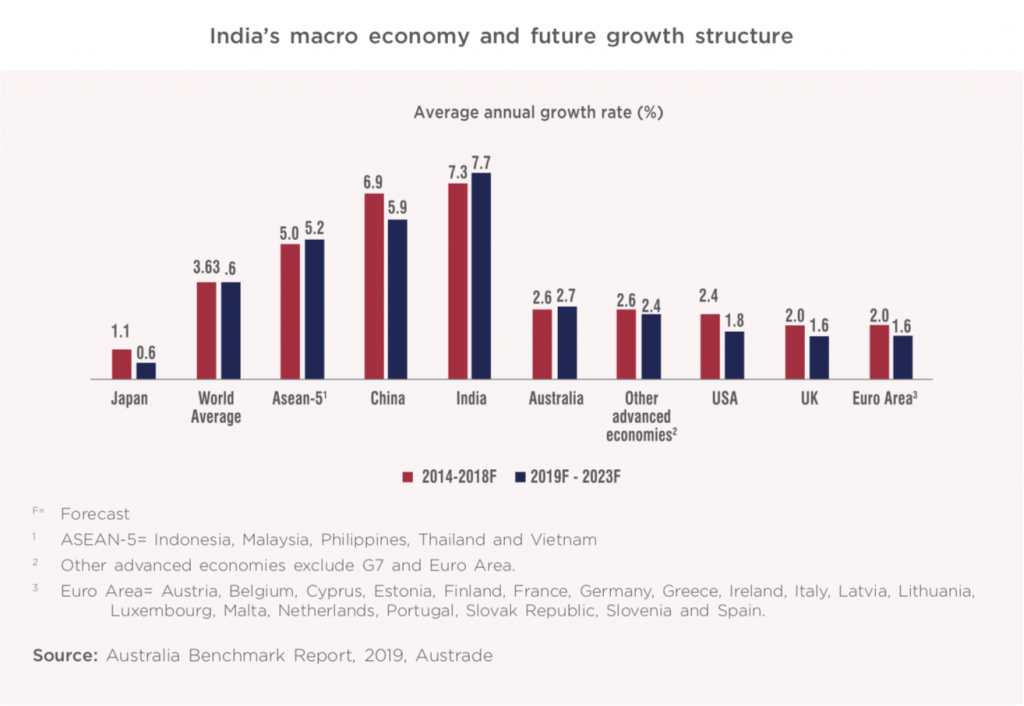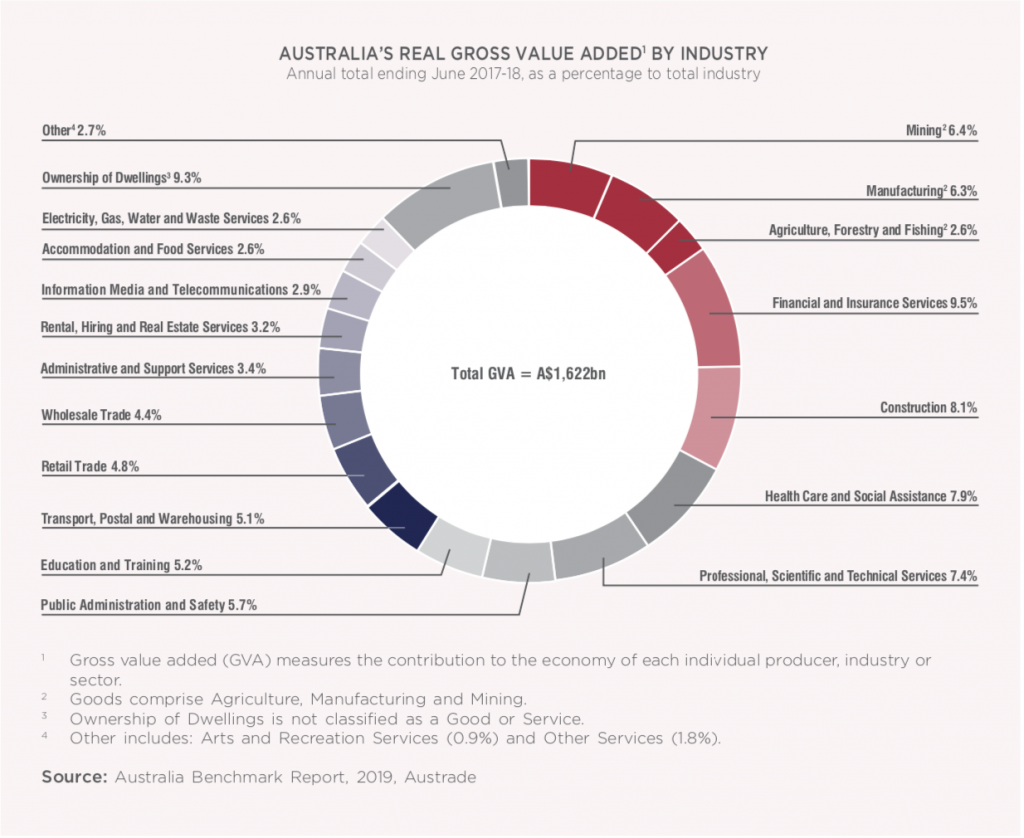Macroeconomic overview
Macroeconomic overview
Australia’s Gross Domestic Product (GDP) has been growing at more than 3%, on average, each year since 1992.3 Australia is currently in its 28th year of consecutive economic growth, implying that the country has remained recession free since 1992.3 Having dodged the impact of the Asian financial crisis, the dotcom bust and the global financial crisis, Australia is the only country in the developed world to have achieved this feat. Australia’s real GDP growth has been the highest among the developed economies. Further, the nation is expected to realize an average annual real GDP growth of 2.7% between 2019 and 2023.4


Often regarded as primarily a producer of agricultural commodities, minerals and energy, Australia is in fact a service- driven diverse economy, where services contribute approximately 75% of the GDP while industry and agriculture contribute approximately 22% and 3% respectively.5 Within the services sector, the country’s sophisticated financial and insurance service industries contribute the highest- approximately 9.5% of GDP

The mining sector has been indispensable to the Australian economy, contributing approximately 6.4% of GDP. Australia is a key producer of gold, lead, zinc, nickel and iron ore. Australia also has the world’s largest uranium and fourth largest black coal resources.6 The key mining regions in Australia are in the states of Western Australia, Queensland and New South Wales.
The mining sector experienced an economic boom in the past decade, characterized by extraordinarily high prices and growing global demand. However, in the past few years, owing to completion of existing resource projects and relatively slow growth in new projects, mining investments have started to decline. The mining sector has now shifted its focus and contributes primarily to exports. Thus, the mining industry is largely export-oriented and since 2007-08, resource exports, including minerals, metals, coal and petroleum, have accounted for 55% of total exports7. All in all, the persistent high demand for resource exports, increase in prices of energy and other bulk commodities and favorable terms of trade have further supported the Australian economy.
Success in the mining space has resulted in prosperity for the states of New South Wales, Queensland and Western Australia and these three states cumulatively account for approximately 62% of population8 and 66% of GDP.9
In addition to mining, the development of services sector has also resulted in economic growth of New South Wales and Victoria. Victoria contributes 23% to GDP and houses approximately 26% of population.8 Together, the four regions account for approximately 90% of population as well as GDP.
In the period between 2007 and 2017, Australia’s exports of goods and services grew from USD 184.80 billion to USD 294.64 billion in value terms.10 In 2016, the services sector accounted for approximately 28% of Australia’s exports. Besides energy and mining-related services, Australia is known globally for the quality of its education, tourism and financial services sectors. The service sector is also known for job opportunities, employing 4 out 5 Australians.11
Australia has a workforce of 12 million people. Almost 40% of workers have a tertiary education qualification or advanced diploma. Australia has one of the highest labour productivity growth rates in the developed world, averaging a 1.7% increase every year over the past 20 years.
Unemployment in Australia has been on a declining trend. In 2017-18, unemployment rate remained between 5.4% and 5.6%. As labour supply in Australia has expanded to meet demand, there is low incentive for the Reserve Bank of Australia (RBA) to increase interest rates. Wage growth in Australia has witnessed a gradual increase and the growth of wages was 2.34% in 2018.12 As of 2017, inflation throughout the country has remained low and steady at 1.9%.
Australia’s robust free-market democracy has benefited from a Government that facilitates vibrant entrepreneurial development. As of 2019, the Government continues to lend support to the services sector and the overall economy by working towards the removal of redundant taxes and negotiating additional free-trade agreements.
3 International Monetary Fund. World Economic Outlook - October 2018
4 IMF’s World Economic Outlook, October 2018
5 Australian Bureau of Statistics Cat. No. 5204.0 Table 5, Gross Value Added (GVA) by Industry, Chain volume measures
6 Geoscience Australia
7 Minerals Council of Australia Website
8 3101- Australian Demographic Statistics, June 2018, Australian Bureau of Statistics, Austrade
9 5220, Table 1- Australian Bureau of Statistics, Austrade
10 Statement of Monetary Policy, Reserve Bank of Australia, November 2018
11 Department of Foreign Affairs and Trade Website
12 Australian wage growth remains sluggish and that’s unlikely to change anytime soon, 2019, Business Insider
Next topic: